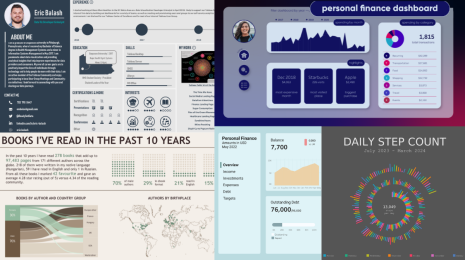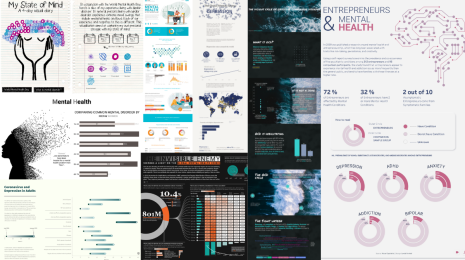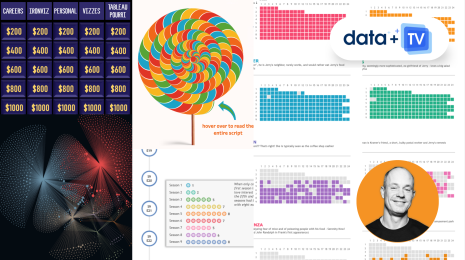Beyond the hook: Building information experiences for attention and engagement
Editor’s note: This is the third post in a series about visual design with data. Read the first here, second here, fourth here, fifth here, and sixth here.
Every audience’s interaction with an information experience begins with choice.
Think of the information you encountered today. It’s an overwhelming amount. Every second, your eyes, ears, and other senses are taking in torrents of data about your surroundings.
For example, let’s consider digital experiences. Digital experiences are information experiences you choose to engage with. As you scroll through your social media feed, with every screen, you make a choice to keep scrolling, pause to look at a particular post, and maybe even engage more deeply by clicking a link or sharing it with your network. You are also making the choice to either spend more time there, or go do something else entirely. The same concept applies to data.
What factors influence our choices?
First of all, it’s important (if obvious) to note that we can only see what we can see. But something has to draw our attention. Something has to stand out from the rest of the deluge of information we are constantly taking in. This could be an unexpected word or phrase, a striking image, or a post or email from someone we know.
What must come next is a little harder. This is where you have to convince me that the attention you’ve just earned is worth more than just a few seconds of my time. You got my attention; now, can you keep it?
My answer will be based on my estimate of the direct and indirect cost of my attention input versus the direct and indirect benefit of the output.
Direct and indirect costs of attention:
| Input | Output | |
|---|---|---|
|
Direct |
How much time and effort will it take for me to deal with this information? |
What will I gain from spending time and effort on this information? |
|
Indirect |
What are the opportunity costs of pursuing this information? |
What are the negative consequences of ignoring this? |
Keeping my attention means making it easier for me to engage with the information and promises that I’ll get something useful out of that information.
How to design for attention (and engagement)
Attention is your first goal when crafting an information experience. You can’t keep the audience around long enough to take in the information you’re sharing if you can’t get them to even glance at it.
Commonly, and colloquially, “attention” is often used to mean intentional, sustained focus—like when a captivating speaker has the audience’s full attention.
Cognitive and neuropsychology identifies two types of attention as completely different processes—involuntary and voluntary attention:
- Involuntary attention involves reacting to external stimuli that our perceptual processing system has evolved to detect. It’s all about spotting and focusing on the shiny new things.
- Voluntary attention involves what we decide to do with said shiny new thing – it’s a deliberate choice we make to focus on it over other things in our environment.
Involuntary Attention: Catching your eye
Optimizing an information experience for involuntary attention is often simpler, because the way it works is more universal. In fact, some of the more common “best practices” in visual design come from how this has evolved in humans. Let’s call this the visual contrast toolbox. The greater the contrast, the easier it is for us to notice the more important things.
This includes:
- Movement: We are great at detecting movement—an evolutionary benefit, to be sure, in the wild. Moving objects, especially in a mostly stationary field, catch our attention with tremendous ease. We even like diagonal lines more than vertical or horizontal lines, merely because they *imply* movement.
- Color: We notice bright and saturated colors, much more than dim or unsaturated ones; this is why we tend to consider brighter-colored objects to be more important, even if they are in all other respects identical.
- Size: We emphasize large objects over smaller ones.We also favor bold text over lightweight text.
- Shapes: We are drawn to text over abstract shapes, particularly if the text could be interpreted as a title.
That leads to the obvious counterpoint: you must use these techniques judiciously, or their effects will be negated. If everything is bold, nothing is bold. If everything is moving, we don’t know where to look first.
We can use these visual contrast tools to make it easier for our audience to notice our data viz. We can also use those tools to optimize the rest of the experience. Part of that is, of course, making design choices at the individual chart level. But even more importantly, we can use our knowledge of these tools to structure the overall composition of our product—the chart or a collection of charts, images, and text—in a way that makes it easier for the audience to notice the important things.
Direct the audience where you want them to look—often, the top, the top left, or whatever the obvious title of the product is—and show them how to interact with the elements of the page so they don’t have to think too much about where or how to do it.
Voluntary Attention: Keeping you engaged
Voluntary attention is much more complex. Ultimately, it’s a decision-making process: is this shiny new thing interesting to me?
It’s at this point where our design choices can no longer be based on tendencies that are universal to (Western) audiences. This is when we will make choices based on our understanding of two relationships from the information communication triangle:
- The creator and the audience
- The audience and the information product
As we explained in the first part of this series, you can’t directly control the relationship between the audience and data viz and you can’t force your audience to pay attention to it. But, you can identify what might help the audience become interested and engaged.
So how do you keep your audience’s attention? To support a successful delta design approach, we suggest considering the following three principles of engagement:
1. Bridge the gap between the known and the unknown.
When we encounter information that surprises us or challenges our current understanding of a topic, it is much more likely to spark our curiosity. This is partly because our brains are attracted to novelty. But it also has a lot to do with how we get motivated to learn: when we become aware of a gap between what we already know and what we want to know.
Remember that chart showing direct and indirect costs of attention? Here’s another application:
| Input | Output | |
|---|---|---|
|
Direct |
How much time and effort will it take for me to fill this knowledge gap? |
What will I gain from learning this information? |
|
Indirect |
What are the opportunity costs of spending time filling this gap? |
What are the negative consequences of remaining uninformed? |
Once we become aware of a knowledge gap, it’s a balance between how interested we are in filling this gap (and conversely with not filling it), and our estimate of the difficulty and likelihood of doing so.
The key word here is balance. It doesn’t mean everything has to be as simple or as easy as possible. It doesn’t mean we abandon anything that can’t be understood under some arbitrary number of seconds.
It’s all about the value of the outputs and whether they outweigh the costs of the inputs. If we’re interested enough in the information, we’re happy to spend more time and mental energy.
And that leads us to the second principle…
2. Make a connection between the unfamiliar and the familiar.
When we encounter information that we can relate to our own lives or experiences, we’re much more likely to want to pay attention. This principle lets us tip that cost/benefit scale. Presenting information in a way that helps your audience see the connection to something they already understand can change the very way they see that knowledge gap.
Analogies and metaphors can make it easier to learn new information. They help us to understand what a number truly means—what it really looks like or feels like. For instance, if a friend said, “I recently lost 25 pounds,” you would hear that number, but maybe not contextualize it; if that friend then said, “That’s the equivalent of three gallon jugs of milk (about 8.5lbs each) that I’m no longer carrying around with me,” you would then have a much stronger, empathetic connection to that data, because it is connected to something familiar.
When you contextualize information, it makes it easier for the audience to understand the true scope, scale, implication, or urgency of a particular problem. This is often called the “the denominator problem”:
- If Mike said, “I ran a 10K yesterday and finished 11th overall,” you would not know whether to be impressed or not, because you are unfamiliar with him, or his running prowess.
- If he said “I finished 11th out of 1400 competitors,” you’d be more impressed, because you are familiar with what 1400 people looks like, and you have a sense of how fast you’d have to be in order to beat out almost all of them.
- And then if he said, “I finished 11th out of 1400 competitors, but everyone else was 80 years old or older,” you’d be way less impressed, because you are also familiar with the expected general fitness level of an 80-year-old vs. a 45-year-old.
3. Understand the connection between the data and you, the creator.
The data and the information product are not about you. But they do start with you. There’s no better way to figure out what might be engaging or interesting about a data set then by thinking about your own relationship with it. You encountered this information first. What did you find so interesting about it? And most important of all: why was it interesting to you?
We make countless decisions during the analysis process. We don’t do them randomly; something in our data and in our investigations pushed us in different directions. Step back and identify the patterns that stood out to you, the threads that you chose to follow, and why they matter to you. After all, if you don’t think it should matter, why should anyone else?
And the next time you’re creating an information product, give these delta design principles on attention and engagement a shot too. In the next post, we’ll be talking about our second delta design goal for success: usability.










